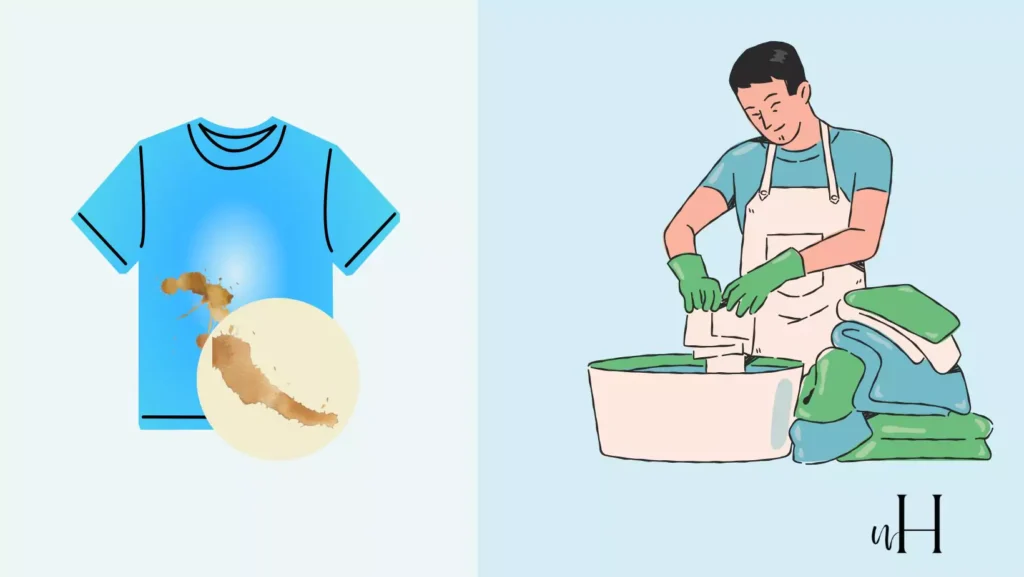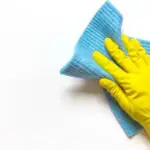Last updated on July 2nd, 2025 at 07:56 am
Grease stains can feel like the hack thing, tiny marks that somehow leave a big impression on your favorite shirt or that perfectly worn-in pair of jeans. Their stubborn nature might make you think it’s time to retire the garment, but with the right techniques, grease stains can almost always be banished. We are sharing expert-approved methods on how to get a grease stain out of clothes without fading, shrinking, or compromising their fabric.
Whether the culprit is buttery popcorn or a cooking mishap, these tailored solutions will help you reclaim your wardrobe because your clothes deserve to shine (not your stains).
Time can be your best friend or worst enemy when dealing with grease stains. If left too long, grease binds to fibers, making removal tough. Act quickly to control the spread and remove oils before they embed further in the fabric.
Expert Insight
According to textile care specialist Dr. Emily Sanders, “the key to successfully removing grease stains is understanding the fabric type and using the appropriate cleaning agents. For sturdy fabrics like cotton or denim, pre-treating with a grease-cutting dish soap can effectively break down oil particles.
RELATED BLOG
- 7-Fastest Ways to Get Rid of Boxelder Bugs Permanently
- How to Clean Fabric Couch-3 Tips By Professional Cleaners
How to Get a Grease Stain Out of Clothes
1. Absorb Excess Grease First
Tackle fresh grease stains by absorbing moisture immediately. Use a powder that draws out grease before it becomes permanent in your clothes.
- What to Use: Baby powder or cornstarch (baking flour works in a pinch).
- Method: Sprinkle powder liberally over the stain ASAP. Let it sit for 10-15 minutes to soak up the oils, then shake off or brush away. Repeat if needed.
Pro Tip: Best for grease on unwashed fabric.

2. Dishwashing Detergent to the Rescue
Clear liquid dish soap is great for tackling grease on fabrics.
- What to Use: Clear, non-dyed liquid dish soap.
- Method: Rub a small amount into the stain using your fingers or a soft toothbrush. Let it sit for 5-10 minutes, then rinse with cool water.
Pro Note: Avoid dyed soaps to prevent discoloration.
3. When in Doubt, Use WD-40 (With Caution!)
For stubborn stains, try WD-40, but follow up with washing to avoid residue.
- What to Use: A dab of WD-40 and a damp microfiber cloth.
- Method: Apply a tiny amount directly on the stain, wait 5 minutes, then launder immediately.
Warning: Suitable only for durable fabrics like jeans, not delicates.
4. Lemon Juice & Vinegar as Natural Heroes
For a chemical-free solution, use lemon juice and vinegar.
- What to Use: Equal parts lemon juice and white vinegar.
- Method: Dab the mixture on the stain, let it sit for 15-30 minutes, then rinse with cool water. Repeat or try dish soap if needed.
Pro Tip: Lemon juice brightens white or light clothing.
5. Baking Soda Paste for Tough Stains
For deeper absorption, use baking soda paste.
- What to Use: Two parts baking soda, one part water.
- Method: Mix into a paste, apply to the stain, and let it dry completely. Once dry, brush off and rinse.
Pro Tip: Safe for delicate fabrics, making it versatile.
6. Pre-Treatment Is Key Before Laundry
No matter which method you use, proper pre-treatment is what ensures your stain-lifting success. Here’s a simple checklist to prepare your garment before letting the washing machine do its job:
- Double-check the stain: Make sure the grease has dramatically faded. If it’s still visible, repeat one of the above methods before washing to avoid heat setting it in.
- Choose the right temperature: Always go for cooler water first; heating a grease-stained garment before it’s fully clean will lock in the residual oils permanently.
- Skip the dryer: Air-drying is essential for ensuring the grease stain is fully eliminated before subjecting the garment to high heat.
Fabrics and Stains Need Specific TLC
Different fabric types react differently to grease removal techniques, so knowing your material is essential to success.
- For Cotton: Dish soap and baking soda methods work best here.
- For Synthetics (like Polyester): Opt for pre-treatments like cornstarch powder and liquid detergent. Synthetic materials can “trap” grease stubbornly, so repetition may be required.
- For Denim: Consider WD-40 or dish soap. Denim is sturdy and can withstand heavy-duty grease-fighting tactics.
- For Delicates (Silk/Wool): Stick with baby powder or cornstarch for a gentle fix. Avoid strong chemicals or vigorous scrubbing.
Dr. Sanders highlights the importance of using cold water to rinse the area, as warm water may set the stain. In cases involving delicate materials such as silk or wool, she advises testing any cleaning solution on a small hidden area first to avoid potential damage. She emphasizes that patience is crucial, recommending multiple gentle treatments if necessary rather than a single overly aggressive approach.“
How to get grease stains out of couch

Grease spills on couches can be daunting, but with the right techniques, you can restore your furniture to its original glory. Here’s how to tackle those stubborn spots:
- Step 1: Blot the Excess Grease
Begin by gently blotting the stain with a paper towel or clean cloth to absorb as much grease as possible. Avoid rubbing, as this can spread the grease further into the fabric.
- Step 2: Sprinkle an Absorbent Powder
Apply a generous amount of baking soda or cornstarch directly onto the stain. These powders work to absorb excess grease. Allow it to sit for at least 15-20 minutes.
- Step 3: Vacuum the Powder Away
After the powder has had time to work its magic, vacuum it up using the brush attachment to ensure every particle is removed along with the absorbed grease.
- Step 4: Apply Dish Soap Solution
Mix a small amount of clear dish soap with warm water to create a soapy solution. Use a clean cloth or sponge to gently dab the solution onto the stain, being careful not to oversaturate the fabric.
- Step 5: Rinse with Clean Water
Once the stain has lifted, dab the area again with a clean cloth dipped in water to rinse out the soap. It’s important to remove all soapy residue to prevent additional stains.
- Step 6: Air Dry Completely
Allow the area to air dry completely before using the couch again. Avoid drying with heat, as this could set any residue left behind.
If the stain persists, repeat the steps or consider using a specialized upholstery cleaner. Always test cleaning methods on an inconspicuous area first to ensure there’s no discoloration.
Avoid These Common Grease-Removal Mistakes
- Avoid Hot Water Early On: Hot water can set the grease stain, sealing it into the fabric permanently. Always start with cool or lukewarm water.
- Don’t Use Heat Immediately Post-Wash: Never toss a freshly washed item into a hot dryer as lingering stains you missed may darken further.
- Skipping Pre-Treatment: Tossing a grease-stained item directly into the washer is rarely effective without pre-treatment.







